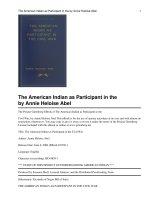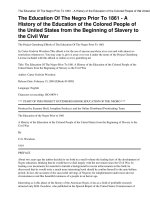Osprey essential histories 005 american civil war (3) the war in the east 63 65
Bạn đang xem bản rút gọn của tài liệu. Xem và tải ngay bản đầy đủ của tài liệu tại đây (5.8 MB, 96 trang )
ROBERT K KRICK was born
in California, and has been
responsible for the preservation
of several battlefields in Virginia
for more than 30 years.
He is the author of a dozen
books and more than 100
published articles. His
Stonewall Jackson at Cedar
Mountain won the Douglas
Southall Freeman Award for
Best Book in Southern History.
PROFESSOR ROBERT O'NEILL,
AO D.Phil, is the Chichele
Professor of the History of War
at the University of Oxford and
Series Editor of the Essential
Histories. His wealth of
knowledge and expertise shapes
the series content, and provides
up-to-the-minute research
and theory. Born in 1936 an
Australian citizen, he served in
the Australian army (1955-68)
and has held a number of
eminent positions in history
circles. He has been Chichele
Professor of the History of War
and a Fellow of All Souls
College, Oxford since 1987.
He is the author of many books
including works on the German
army and the Nazi party, and
the Korean and Vietnam wars.
Essential Histories
The American Civil War
The war in the East 1863-1865
First published in Great Britain in 2001 by Osprey Publishing,
Elms Court. Chapel Way. Botley, Oxford OX2 9LP
E-mail:
please contact:
© 2001 Osprey Publishing Limited
Osprey Direct UK. PO Box 140.
Wellingborough, Northants. N N 8 4ZA. UK
Email:
All rights reserved. Apart from any fair dealing for the purpose
of private study, research, criticism or review, as permitted under
the Copyright Design and Patents Act, 1988. no part of this
publication may be reproduced, stored in a retrieval system, or
transmitted in any form or by any means, electronic, electrical,
chemical, mechanical, optical, photocopying, recording or
otherwise, without the prior written permission of the copyright
owner. Enquiries should be made to the Publishers.
For a complete list of titles available from Osprey Publishing
Osprey Direct USA,
c/o Motorbooks International. PO Box 1,
Osceola. Wl 54020-0001. USA.
Email:
www.ospreypublishing.com
Every attempt has been made by the Publisher to secure the
appropriate permissions for material reproduced in this book If
there has been any oversight we will be happy to rectify the
situation and written submission should be made to the
Publishers.
ISBN 1 84176 241 5
Editor: Rebecca Cullen
Design: Ken Vail Graphic Design. Cambridge. UK
Cartography by The Map Studio
Index by Alan Thatcher
Picture research by Image Select International
Origination by Grasmere Digital Imaging, Leeds. UK
Printed and bound in China by L.Rex Printing Company Ltd
01
02
03
04
05
10
9
This volume is one of four books on the American Civil War in
the Osprey Essential Histories series
Contents
Introduction
Chronology
7
12
Warring sides
From innocents to warriors
14
The fighting
The war without Jackson to Lee's last stand
17
Portrait of a soldier
McHenry Howard's war
76
The world around war
T h i s h o r r i d a n d senseless w a r ...'
81
Portrait of a civilian
Ella Washington and the Federal Army
83
How the war ended
From Appomattox to Liverpool
88
Conclusion and consequences
89
Recovery and reconstruction
93
Further reading
94
Index
The United States in I860
Introduction
Robert Penn Warren, Pulitzer Prize winner
and American Southerner, has suggested that
the Civil War rivets the attention of readers
because of the striking human images it
offers for contemplation - 'a dazzling array
of figures, noble in proportion yet human,
caught out of Time as in a frieze, in stances
so profoundly touching or powerfully
mythic that they move us in a way no mere
consideration of "historical importance" ever
could.' Most of those towering figures who
carry a special aura functioned in the war's
Eastern Theater, which is the focus of this
volume. Lee, Jackson, Grant, and others of
the American soldiers who fought that war
continue to fascinate modern students.
The Osprey Essential Histories series
divides the story of the American Civil War
into four volumes. The rupture of the United
States into two nations in 1861, detailed in
The American Civil War: The war in the East
1861-May 1863, by Gary Gallagher, led to a
vast internecine war. Hundreds of thousands
of young men eagerly embraced the
adventure of war. They joined volunteer
units near their homes and cheerfully,
innocently, headed away to what seemed
surely to be a short, clean conflict. It would
end, they felt certain, in victory for
whichever of the contending sides they
embraced. The frolicsome aspect of war
dissipated in the intense mayhem along Bull
Run, on the plains of Manassas, in July 1861.
For months thereafter, thousands of boys in
both armies died of disease. Many of the
rustic youngsters-turned-soldiers had never
been far from rural homes and they fell prey
in droves to common childhood diseases
such as measles.
Gallagher, The American Civil War,
presents the story of the first half of the war
in Virginia. After a relatively quiet first year
of the war, the spring of 1862 ushered in
months of steady campaigning in Virginia
and Maryland, across the narrow swath of
country between the contending capital
cities of Washington, DC, and Richmond,
Virginia. General Robert E. Lee assumed
command of the Confederate Army of
Northern Virginia on 1 June 1862, and with
it drove the besieging Federal Army of the
Potomac away from Richmond. During the
11 succeeding months, Lee steadily defeated
an array of opposing generals: George B.
McClellan, John Pope, Ambrose E. Burnside,
and Joseph Hooker. The arenas in which Lee
conquered that succession of enemies are
among the most famous in American
military history: the Seven Days' Campaign,
Second Manassas (or Bull Run), Antietam,
Fredericksburg, and Chancellorsville.
This second volume covers the war in
the Eastern Theater from June 1863 to the
surrender at Appomattox in April 186S. In
the aftermath of Chancellorsville, the war
in Virginia was about to undergo a
fundamental change in tenor. The enormous
Northern advantages in industrial might and
population numbers would affect operations.
With his invaluable lieutenant, 'Stonewall'
Jackson, dead, Lee would find his options
narrowed. Hoping to retain the initiative,
Lee grasped the momentum offered by
Chancellorsville and surged northward into
enemy territory. When he returned after
Gettysburg, the nature of the war in Virginia
would trend steadily away from Confederate
opportunities, and toward eventual
Unionist victory.
The great Battle of Gettysburg opened this
second phase of the story. From Wilderness
and Spotsylvania Court House the next
spring, the contending armies moved to an
extended siege of Petersburg, and eventually
to the Confederate surrender at Appomattox.
The Confederate Army of Northern Virginia
8
Essential Histories • The American Civil War
Introduction
9
(Public domain)
10
Essential Histories • The American Civil War
Introduction
followed General Robert E. Lee through the
entire period. That army's sturdy, if ill-led,
counterpart was the Union Army of the
Potomac. General George G. Meade took
over the Army of the Potomac just a few
hours before its great victory at Gettysburg,
and retained that command to the end of
the war. The arrival of the commander of all
Union armies, General U. S. Grant, in the
field near the Army of the Potomac in the
spring of 1864 overshadowed Meade and he
never has received the immense credit that
he deserves for winning the war.
Wars invariably generate momentum of
their own, leading to results that neither side
envisioned, or would have tolerated, at the
outset. By 1864 the old-fashioned war of
1861-63, caparisoned with the trappings of
antique chivalry, had given way to what
aptly has been called 'the first modern war.'
Railroads for the first time played an
essential role. Industrial and mechanical
might weighed in as heavily as tactical
prowess and strategic skill. Troops who had
been scornful of earthworks in 1861
frantically dug dirt in 1864 at every
opportunity, to protect themselves. Perhaps
most significantly, most in the modern vein,
civilians and their property became the
targets of military power.
From June 1862 to May 1863. Confederate General
Robert E. Lee had steadily defeated an array of opposing
Federal generals. (Author's collection)
11
As have most attempts to win
independence and freedom over the
centuries, the efforts to create a Confederate
nation had to rely upon wearing down the
will of their foe. Southerners had nothing
remotely like the means to (or any interest in)
subjugate their opponents as a vassal state;
they merely longed to be let alone. Perhaps
the most important day in the second half of
the war, therefore, was 8 November 1864,
when the Northern populace voted a second
term for President Abraham Lincoln - who
had been certain a few weeks earlier that he
would lose. With the aggressive war party still
in power in the North, determined to win the
war, Confederates had no hope of beating an
enemy with thrice the military population
and virtually all of the continent's
industrial capacity.
The surrender at Appomattox followed
inevitably, leaving behind legendary
battles and leaders who remain among the
most-studied military topics in the English
language. The war also left a ghastly harvest
of more than 620,000 dead men in its wake,
by far the largest proportional loss in
American history; freed several million black
men and women from slavery; and created
an unmistakable watershed in United
States history.
Chronology
1863 10 May Confederate General
'Stonewall' Jackson dies
9 June Cavalry battle at Brandy
Station
14-15 June Second Battle of
Winchester
28 June General George G. Meade
replaces Joseph Hooker in command
of the Federal Army of the Potomac in
the midst of the campaign, just before
the war's largest battle
1-3 July Battle of Gettysburg
13-14 July Lee's Confederates recross
the Potomac river into Virginia,
ending the main phase of the
Gettysburg campaign. At the same
time, frenzied mobs in New York City
riot in opposition to conscription,
killing or wounding hundreds of
victims, many of them black citizens
resented as a visible cause of the war
and the draft.
8-14 September Lee detaches General
Longstreet with one-third of the
army's infantry to go west and
reinforce Confederate operations in
Georgia and Tennessee. Meade moves
south against Lee, but only heavy
skirmishing results.
14 October Battle of Bristoe Station
7 November Battle of Rappahannock
Station
19 November President Lincoln
delivers the Gettysburg Address
26 November-2 December Battle of
Mine Run
8 November President Lincoln issues
a Proclamation of Amnesty and
Reconstruction, offering pardons to
any Confederate willing to take an
oath of allegiance
1864 9 March Grant is commissioned
lieutenant-general, to command all
Federal armies. He would make his
headquarters with the Army of the
Potomac, and soon exert virtually
direct command over it.
4-6 May Battle of the Wilderness
8-21 May Battle of Spotsylvania
Court House
11 May Battle of Yellow Tavern;
General J. E. B. Stuart is mortally
wounded and dies the next day
15 May Battle of New Market
23-27 May Battle of the North Anna
River
1-3 June Battle of Cold Harbor
5 June Battle of Piedmont
12 June Army of the Potomac starts
move to cross James river
15-18 June Opening engagements
around Petersburg, while Confederate
General Jubal Early arrives near
Lynchburg to launch his long
and crucial campaign in the
Shenandoah valley
22-23 June Battle for the Weldon
Railroad near Petersburg
9 July Battle of Monocacy
11-12 July Early's Confederates stand
on the outskirts of Washington;
President Lincoln comes under
long-range fire
24 July Second Battle of Kernstown
30 July Dramatic explosion of mine
at Petersburg turns into the Battle of
the Crater
18-25 August Battles of the Weldon
Railroad and Reams' Station
23 August Lincoln submits to his
cabinet a sealed memo stating that 'it
seems exceedingly probable that this
Administration will not be re-elected,'
and pledging support after the election
to the president-elect
Chronology
14-17 September The Beefsteak Raid
19 September Third Battle of
Winchester
22 September Battle of Fisher's Hill
29 September-7 October Fighting
around Richmond and Petersburg at
Fort Harrison, Chaffin's Bluff, New
Market Heights, Darbytown Road, and
Boydton Plank Road
9 October Cavalry fight at Tom's Brook
19 October Battle of Cedar Creek
27 October Battle of Burgess' Mill
8 November President Lincoln
re-elected with 55 percent of popular
vote
1865 5-7 February Battle of Hatcher's Run
6 February Lee appointed
Commander-in-Chief of all
Confederate armies by Congress,
against President Davis's wishes - far
too late to affect the prosecution of
the war
2 March Early's last remnant
destroyed at the Battle of Waynesboro
4 March Lincoln's Second Inaugural
Address, 'With malice toward none ...'
13
13 March Confederate Congress
approves raising of black troops
25 March Attack on Fort Stedman
near Petersburg
29-31 March The final campaign in
Virginia begins with fighting around
Dinwiddie Court House
1 April Battle of Five Forks
2 April Confederate government
evacuates Richmond
9 April Lee surrenders to Grant at
Appomattox Court House
14 April Lincoln assassinated at
Ford's Theater in Washington
1866 2 April State governments
having been installed to meet
Unionist directives, President
Andrew Johnson officially proclaims
'that the insurrection ... is at an
end and is henceforth to be
so regarded'
1877 The last enforced military government
in the ex-Confederate states is
removed, and home rule is restored at
the state level
Warring sides
From innocents to warriors
No American war, and few of any other sort,
has ever been fought with a lower
proportion of trained soldiers than the
American Civil War. The United States had
from its origins suffered from a deep mistrust
of standing armies and professional military
men. The nation also wallowed in a
nostalgic, but misguided, fondness for the
notion of an untrained but devoted citizenmilitia. At the outbreak of war in 1861, the
United States Army included fewer than
15,000 officers and men; a few months later
there would be more than one hundred
times that many men under arms - far too
many troops for the regular army to serve as
an effective cadre.
A computerized index of official service
records of both the Union and Confederate
armies, completed in the year 2000, has for
the first time made available hard data about
the number of men mustered into service
during the war. This is a subject about which
arguments have raged among partisans of
each side, and of various states, since the war
years without any means of clear resolution.
We now know that 1,231,006 Confederate
service records exist, and 2,918, 862 Federal
records. Virginia supplied the largest
Confederate increment, followed by Georgia
and Tennessee. New York (456,720) led
Federal recruitment, followed byPennsylvania and Ohio. Those three
Northern states, in fact, among them
supplied almost as many troops as the entire
Confederacy could muster. It should be
recognized that the number of records does
not indicate a precise number of men. Some
Northern troops re-enlisted in different units
at the expiration of a term of enlistment,
and many Southern soldiers changed
organizations in the spring of 1862 under
the working of the new conscription law.
Even so, the newly established totals of
Warring sides
service records constitute the first
unmistakable benchmark on the subject.
Civil War soldiers almost without
exception had been civilians in 1860. The
census that year revealed the overwhelming
advantages the Union enjoyed in numbers.
The seceded states had a population of
9.1 million, 5.4 million of them white and
therefore directly available for military
Confederate volunteers head off for war in 1861.
(Public domain)
15
16
Essential Histories • The American Civil War
service. The other states counted
22.3 million inhabitants, and more than
800,000 alien passengers arrived at Northern
ports during the war. The agrarian
Confederacy faced even greater challenges in
materiel. The 1860 census showed the South
with only 7 percent of the nation's industrial
output, 8 percent of its shipping, and
one-fourth of its railroad mileage.
The capacities of the warring sides,
described in detail in The American Civil War:
The war in the East 1861-May 1863, had
begun by 1863 to play a steadily more
important role in the progress of the
conflict. The United States navy held
unmistakable sway over all navigable waters,
without any notable opposition. As a result,
the portion of the Virginia Theater viable for
Confederate operations extended no farther
east than the fall lines of the several rivers
flowing nominally eastward through the
state: the Potomac, the Rappahannock, the
James, and the Appomattox. Federal
weaponry outmatched Southern equipment
in every way. Union infantry carried rifles
almost exclusively, while a substantial
proportion of Confederates still had to make
do with smoothbores (with one-tenth the
range). As the conflict wore on, Northern
cavalry would enjoy the advantage of
breech-loading carbines, and eventually of
repeating weapons. Union artillery fired
farther and more accurately than Southern
cannon, and Northern ordnance usually
exploded on cue, whereas a Confederate
battalion commander at Chancellorsville
reported that only one in every 15 of his
shells detonated.
By the spring of 1863, the organization
and command of the main armies of the
Virginia Theater had taken on distinctive
characteristics. The Union Army of the
Potomac had been tempered into a
strong, resolute, military implement, patient
in the face of steadily inept leadership.
If President Abraham Lincoln would ever
place a capable commander over the army,
and support him, the veteran organization
stood ready to be the bulwark of the
national cause. The Confederate Army of
Northern Virginia had long enjoyed superb
direction from Lee, but without Stonewall
Jackson to execute Lee's daring initiatives,
a new mode of fighting would now
be necessary.
As the contending armies in the Virginia
Theater moved north in the late spring of
1863, away from Chancellorsville, they were
pursuing a long and tortuous road that
would lead them eventually to Gettysburg.
They also were launching a new phase of the
American Civil War.
Tredegar Iron Works in Richmond provided invaluable
war materials, but the Confederacy had relatively few
such industrial facilities. (Public domain)
The fighting
The war without Jackson to
Lee's last stand
The spring of 1863
A great, mournful cry went up all across the
Confederacy as news spread in May 1863 of
the death of General Thomas J. 'Stonewall'
Jackson, of wounds received at the Battle of
Chancellorsville. A Georgia Confederate
wrote dolefully on 15 May that 'all hopes of
Peace and Independence have forever
vanished.' Another Confederate told his wife
back in Alabama, with more earnestness
than literary precision: 'Stonewall Jackson
was kild ... I think this will have a gradeal to
due with this war. I think the north will
whip us soon.' General Robert E. Lee faced
the daunting task of reorganizing his
army in Jackson's absence, and filling it
with a sturdy spirit that could keep the
'whip us soon' forecast from becoming a
self-fulfilling prophecy.
Lee's stunning victory at Chancellorsville
on 1-6 May, against daunting odds, had
generated enough momentum to carry the
Confederate Army of Northern Virginia
northward on a new campaign. (For
Chancellorsville, see Gallagher, The American
Civil War.) Before he could launch such an
effort, though, Lee had to reorganize his
army to fill the yawning chasm left by
Jackson's demise. He decided to go from the
two-corps system that had worked so long
and well for managing his infantry to an
organization in three corps. The veteran
General James Longstreet, reliable if
contentious, kept command of the First
Corps. General Richard S. Ewell, returning
after nine months of convalescing from a
wound, assumed command in late May of
Jackson's old Second Corps. General A. P. Hill
won promotion to command a new Third
Corps composed of pieces extracted from the
other two, combined with a few new units
drawn to Virginia from service elsewhere in
the Confederacy. General J. E. B. Stuart
remained in command of the army's capable
cavalry arm. Lee's artillery benefited from an
excellent new organization into battalions,
and from an officer corps that included many
brilliant young men; but at the same time it
suffered from inferior weaponry and at times
from woefully inadequate ammunition.
Across the lines, General Joseph Hooker's
Army of the Potomac loomed in Lee's way.
The seasoned Northerners in that army by
now knew their business thoroughly well
and stood ready to continue their role as
bulwark of the Federal Union. What they
wanted and needed was a competent
commander. At Chancellorsville, Hooker had
demonstrated beyond serious contention
that he was not such a man. The Army of
the Potomac would finally receive a leader
who matched its mettle in late June, but as
the 1863 campaign unfolded, Hooker's
palsied hand remained at the helm. His
veteran corps commanders offered reliable
leadership at the next level below Hooker.
After two consecutive battles along the
line of the Rappahannock river, both armies
knew the countryside intimately. Lee had
won both battles in resounding fashion, but
had not been able to exploit the victories
into overwhelming triumphs that destroyed
his enemy. Now he proposed to move north
across the Potomac and carry the war into
the enemy's country. Political hyperbole
(including President Lincoln's famous
'Gettysburg Address') always insisted that the
Confederates hoped to conquer the North
and subjugate that much larger portion of
the continent to some sort of serfdom. Such
rodomontade, of course, reflected nothing of
actual Southern aims.
Lee's move north must be recognized as a
raid, not an invasion designed to conquer
Pennsylvania or any other territory. He sought
18
Essential Histories • The American Civil War
The Campaigns in the Virginia Theater 1863-65
The fighting
to lift the heel of war from Virginia, not only
for humanitarian reasons, but also to allow
that home country to recover from hostile
occupation so that it could sustain Lee's army
in future months. The country north of the
Potomac also offered a much wider field for
The Confederate high tide at Chancellorsville
propelled Lee's army into a new campaign that
swept north past Winchester into Maryland and
then Pennsylvania, where the Federal Army of the
Potomac repulsed it in the war's largest battle. During
the fall of 1863, the two armies clashed again in Virginia
at Bristoe Station, Rappahannock Station, and Mine Run,
but none of those engagements developed into a major
battle. The next spring, with Commander-in-Chief
U. S. Grant accompanying it. the Army of the Potomac
crossed the Rapidan river and fought at Wilderness
and Spotsylvania. Although they could not defeat Lee.
the Federals determinedly pushed on to the North
Anna Riven Cold Harbor; and the outskirts of Richmond
and Petersburg. After 10 months attempting to
break into the Confederate capital, Grant finally
succeeded in April 1865 and Lee was forced to
surrender at Appomattox Court House on the 9th.
19
The Confederates counterattack at Brandy Station.
(Painting by Don Troiani, www.historicalartprints.com)
maneuver, a military element in which Lee
excelled. An ostensible threat to the Federal
political capital in Washington also held out
potential advantages: knowing that his enemy
must keep the city covered foreshadowed in
mirror image the 1864 campaign in which
Richmond served as a similar focus and pivot
for Lee on the defensive.
Lee moved away from Fredericksburg and
the Rappahannock river line early in June
1863, and headed northwestward through
piedmont Virginia toward the Shenandoah
valley. On 9 June his cavalry force fought
one of the largest all-mounted engagements
of the war around Brandy Station. Hooker
had sent his own cavalry out with orders to
'disperse and destroy' the Confederates they
found, and the Northern troopers came close
to doing that. They completely surprised the
20
Essential Histories • The American Civil War
usually vigilant Southern mounted men
early in the morning and drove them some
distance. A rally on the low, rounded
eminence of Fleetwood Hill saved the day for
General Stuart's men. They inflicted about
1,000 casualties on the Northern attackers
and suffered half that many themselves.
General Joseph Hooker. (Public domain)
Brandy Station ended as a tactical draw, but
Union troopers who had been battered
relentlessly for two years had finally stood
up to their adversaries and now had a
positive experience upon which to build.
The fighting
General J. E. B. ('Jeb') Stuart led most of the Confederate cavalry on a long ride around the
Federal army en route to Pennsylvania, thus depriving Lee of his 'eyes and ears' as he
maneuvered toward Gettysburg. (Public domain)
21
22
Essential Histories • The American Civil War
The Battle of Gettysburg
'Jeb' Stuart's Southern cavalry again occupied
center stage as the armies sidled northward
and crossed the Potomac - or, more
accurately, Stuart's cavalry exited stage right
and became conspicuous by their absence.
While Lee pushed north, into and through
the Shenandoah valley, Stuart embraced the
chance to ride a raid entirely around the
Union army. He had done just that twice
before, in June and October 1862. This time
the dashing maneuver backfired in deadly
fashion. The cavalry detachment
accompanying the main force in Stuart's
absence had neither the men nor the
leadership necessary to perform the essential
function of screening Lee from enemy view,
while simultaneously finding the enemy and
tracking his progress and intentions. When
Stuart finally rejoined Lee very tardily at
Gettysburg, the commanding general said
quietly, but in clear rebuke, 'Well ... you are
here at last,' and 'I had hoped to see you
before this.' Stuart's ride became one of the
most-disputed subjects among postwar
Above. General George Gordon Meade took command
of the Federal Army of the Potomac scant hours before
the Battle of Gettysburg, but still won a great victory
there. He has never received the credit he deserves for
his achievement, largely because he scorned journalists
and belonged to the wrong political party.
(Public domain)
Left. Confederate General James Longstreet's behavior
on 2 July remains the most controversial aspect of the
Battle of Gettysburg. (Public domain)
Right. The war's largest battle engulfed the farms and
hillsides around Gettysburg, Pennsylvania, on the first
three days of July 1863. The Confederate army won a
tremendous victory northwest of town on 1 July and
swept through the streets in triumph. The Federals made
a stand on a fishhook-shaped line south of Gettysburg,
taking advantage of the slopes of Cemetery Ridge and
anchored on the formidable heights of Culp's Hill and
Little Round Top. Lee's efforts against the Federal right
on 2-3 July met with very little success, but near the
Round Tops the Confederates came close to a major
success. On 3 July, with his options dwindling, and loath
to return to Virginia. Lee flung his center across open
fields toward Cemetery Ridge. This attack, usually known
as 'Pickett's Charge,' unfolded with immense drama and
elicited tremendous courage from its participants, but
yielded nothing for Lee but daunting casualties. He now
had no choice but to retreat south toward Virginia.
The fighting
The Battle of Gettysburg, 1-3 July 1863
23
24
Essential Histories • The American Civil War
Confederates, and remains controversial
to this day.
While Stuart galloped fecklessly across
northern Virginia and Maryland and
Pennsylvania, Lee's infantry achieved
notable success at Winchester, Virginia, on
14-15 June. Ewell's energy and success there
prompted Southerners to hope that he would
emerge as a sort of reincarnation of
Stonewall Jackson. On through Maryland
and deep into Pennsylvania the Confederate
columns pressed. Some of them reached
Carlisle and York and the outskirts of the
state's capital city, Harrisburg. Fighting
The fighting
at the crossroads town of Gettysburg that
began on 1 July would draw all of them back
south into the maw of the war's greatest
battle. The long columns of blue-clad
Union troops marching north through
an arc surrounding Washington also wound
up adjusting their route of march for that
25
place. Gettysburg was a 'meeting
engagement' in every sense. No one picked
the battle site. Roads drew small contending
A nineteenth-century view looking northwest from
the crest of Little Round Top across the scenes of the
heaviest fighting in the history of North America.
(Public domain)









